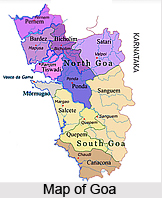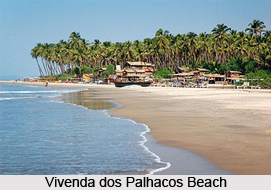 Goa is one of the states in India that is abundant in natural beauty. It is renowned for its beaches. Goa is also known for its world heritage architecture. The Basilica of Bom Jesus in Goa is one of the biggest Christian pilgrimage sites in Asia. Goa has rich flora and fauna as it is located on the Western Ghats mountain range in India. This place is actually the early name of Goa. Some Sanskrit texts uses the words as `Gopakapuri` or `Gapakapattana` for Goa. These names find reference in sacred Hindu texts as Harivansa. In the Skanda Purana, Goa is mentioned as Gomanchala. In the Indian Puranas, Goa is mentioned as Gove, Govapuri, Gopakpattan, and Gomant.
Goa is one of the states in India that is abundant in natural beauty. It is renowned for its beaches. Goa is also known for its world heritage architecture. The Basilica of Bom Jesus in Goa is one of the biggest Christian pilgrimage sites in Asia. Goa has rich flora and fauna as it is located on the Western Ghats mountain range in India. This place is actually the early name of Goa. Some Sanskrit texts uses the words as `Gopakapuri` or `Gapakapattana` for Goa. These names find reference in sacred Hindu texts as Harivansa. In the Skanda Purana, Goa is mentioned as Gomanchala. In the Indian Puranas, Goa is mentioned as Gove, Govapuri, Gopakpattan, and Gomant.
History of Goa
In the 3rd century Goa was part of Maurya Empire. Later it was ruled by the Satavahanas of Kolhapur. Then the Chalukyas of Badami ruled over it. Goa was successively ruled by the Silharas, Kadambas and Chalukyans for the next few centuries. Goa came under the governance of Delhi Sultanate in 1312 AD and1370 AD. In 1498 AD, Vasco da Gama was the first European to set foot in India through a sea route, landing in Calicut followed by his arrival at Goa. The Portuguese arrived at Goa with the target of setting up a colony and claiming control of the spice trade from the European powers after the traditional land routes to India were closed by the Ottoman Turks. On the 19th of December 1961, India took over Goa after Indian troops fought a long battle with the Portuguese. On May 30, 1987, Goa was declared as India`s twenty-fifth state.
Geography of Goa
Goa is situated on the west coast of India in the region of the Konkan, which is an escarpment rising up to the Western Ghats that separates it from the Deccan Plateau. Goa is surrounded on the north by Maharashtra, to the east and south by Karnataka and at the western coast by Arabian Sea. Goa is a part of Konkan area. The main rivers of Goa are the Mondovi, the Zuari River, the Terekhol, Chapora River and the Sal.
Administration of Goa
The legislative capital of Goa is Porvorim, which the seat of the Goa Assembly. The judicial capital of the state is Mumbai and the state comes under Bombay High Court. At Panaji, there is a bench of the High Court. In the bicameral parliament of India, Goa contributes one seat to the Rajya Sabha and two seats to the Lok Sabha. The legislature of Goa is unicameral. There are two districts in Goa. The two districts of Goa are North Goa district and South Goa District. Panaji is the headquarters of North Goa. North Goa district is situated to the North of the Arabian Sea.
 Demographic of Goa
Demographic of Goa
The total population of Goa as per the census of 2011 is 1457723. Its literacy rate is 87.40 %. The three main religions in Goa are Catholicism, Hinduism and Islam. Roman Catholicism established its roots in Goa in 1498 when Portuguese explorer Vasco da Gama arrived on the Malabar Coast. The major cities of Goa are Vasco, Margao, Marmagao, Panjim and Mapusa. Konkani language is the official language of Goa.
Economy of Goa
Tourism is one of the major industries of Goa. Agriculture is one of the important economic activities of Goa. Animal husbandry and the veterinary services form an important sector of rural economy. Goa has varieties of fish like prawns, mackerels and sardines. Mining is also an important industry in Goa.
Tourism of Goa
Goa is known as tourists` paradise. The scenic beauty, architectural splendours of its churches and old houses have made it a favourite with travellers around the world. The tourist season in Goa begins around late September and continues till March. The weather during these months is pleasantly cool. Besides the natural beauty, the beaches and sunshine, the laid-back, peaceful, warm Goan people make it one of the best tourist destinations.






